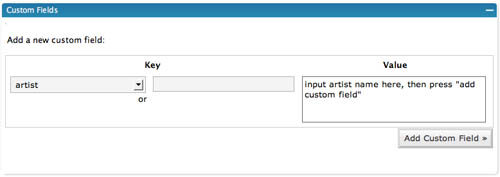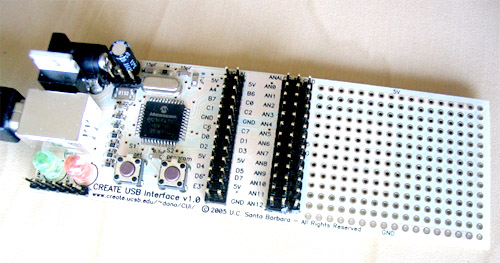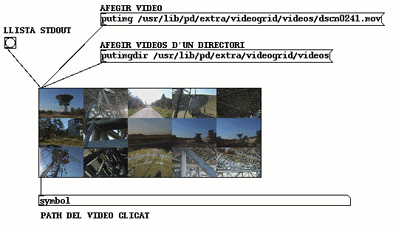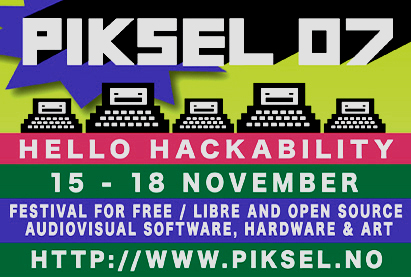This Weekend ! STRP – Festival for Art&Technology in Eindhoven (NL)
tagr.tv is there so watch out for news!
This Weekend ! STRP – Festival for Art&Technology in Eindhoven (NL)
tagr.tv is there so watch out for news!
We have 3 more Authors that want to share their experiences on festivals with the world, i’m sending a triple HUURRAY! to Amsterdam(NL) , Nantes(FR), and Vienna (AT)!
At the tagrtv.community forum you’ll find a basic howto – this is also the place to post your suggestions and questions.

Also we managed to embed Eyebeam’s reBlog. We did this in order to provide an easy possibility for people who already run a blog and want to post some of their content on tagr.tv. If you want to provide tagr.tv with a rss feed, please get in contact.
Vunhat Tan(VN) Lasse Marhaug (NO) Gisle Frøysland (NO) set the record straight: Piksel likes Noise, Piksel produces Noise. I can’t say anything about the way they generated their sound, but the way the video signal is generated is as simple as great: Gisle plugs the audio signal to an ancient video mixer, sends it to another video mixer and back again, some feedback, some analog keying, some analog filters – thats it. I like :)
I couldn’t attend to the presentation of this new tool, but i still want to spread the information it because – as far as i can say from the distance – it’s a very interesting low-cost development: The CUI is a interface board that lets you connect up to the 13 analog inputs (10-bit resolution) and buttons/switches to the digital inputs. It’s is kind of similar to the Arduino board with one big difference: It will be recognized by the system as a USB HIDevice, which means that you can get the data from the sensors into max/pd/suppercollider easily using the [hidio] object.

It’s based on a PIC processor, so you can of course also program it in both C and assemler – if you can. The Create USB Interface is available pre-built and bootloaded for $50 on the Create USB Interface homepage. There are also the schematics and part-lists available for download if you fancy soldering it on your own.
Yves Degoyon and Lluis Gomez and presented their recent pdp development PDVJ “pure data visual junk” – it’s all about image processing and visual work within pd that include helpful objects like a colorgrid to pick a color or a videogrid that shows all the videos of a folder.
also opencv (opencomputervision) will be included in pdp in something like a month. Its in full developement at the moment, they were finishing the pdp_opencv_blob object (a blob detection object) right before the talk, so this is cutting edge information. i can’t wait for this one.

also i’ll finally have to get a new computer because all the pdp stuff is done for linux – it also works on osx, but since you have to run X11 on aqua it will not be as fast as on linux. becaused it seems to be loads of work, it’s not planned to port it to window$ ;)
because of dependency problems it won’t be included to pd-extended, you’ll have to install it on your on.

Maybe some of you have already seen this at the Ars Electronica – an elastic rope connects two excenter points that are driven by electric motors and controlled by an arduino – so simpel, so nice. One of the most beautiful installations i have seen within the last years.
The installation uses a long piece of rope to make a 3-D representation of a group of waves floating on the space. These waves generate sound because of the physics of movement, so sound and images are linked, making only one shape: the rope which creates the volume, creates simultaneously the sound when the rope cut the air.
I liked this one because of ti’s simplicity: Of course you could do this with max, using a micro-controller to synchronize the movement of the mirrors with the video – or you could just connect a photo-transistor via a few resistors to a stepper motor driver and shine on the phototransistor wenn the mirror is supposed to move up, like Ralph did.
This video installation is possible by combining video projection with physical computing. The projected image will be divided in five parts. The light spots in the video are responsible for controlling the movements of the mirrors and synchronizing the movement of the (virtual) video-image and the (real) mirrors
I met Julien at the Piksel Festival last year for the first time: He did a workshop about DIY sinus generators and the at the last evening he did the noisiest and loudest performance i ever attended, no doubt about that. The Installation he did this year is something like a logical consequence for me. Choas, noise, and really loud:
Arougate is an installation that involves the environnement of the space he is invited to hunt in. Arougate is a digital beast who hunts information, tracks it, feeds on it, and generally reacts to it. Arougate behaves like a wolf when he eats his preys ; no one can disturb him without consequence.


I arrived at the Piksel Festival and i’m about to gather all the documentation material – be sure to come back for more soon..
Socialize